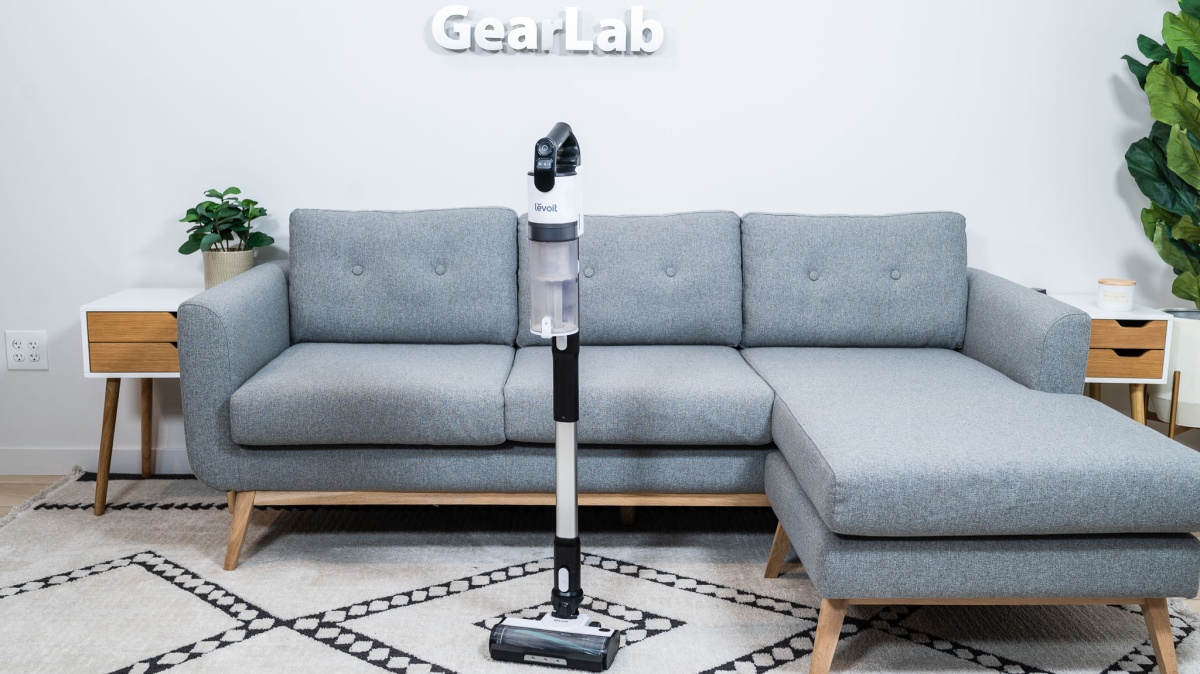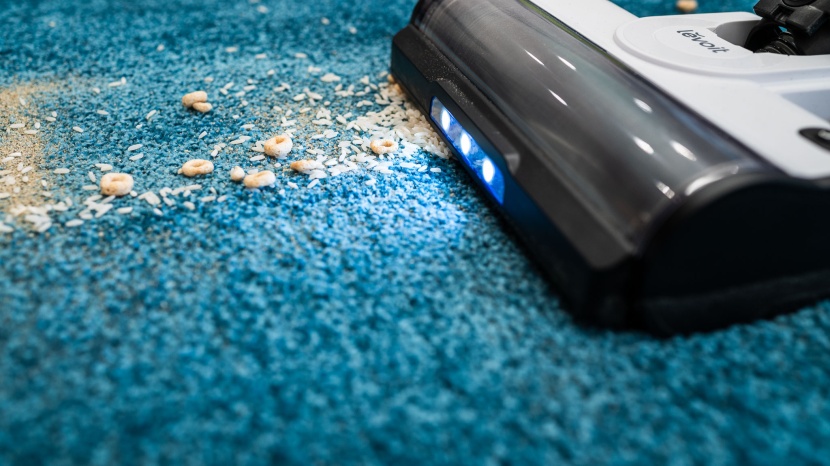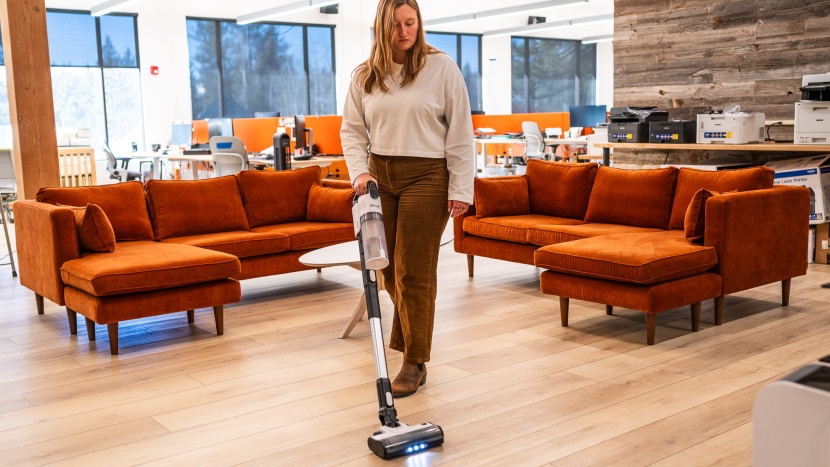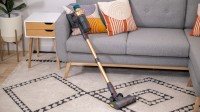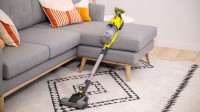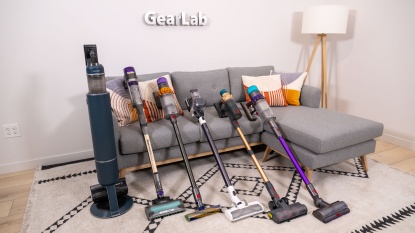
Our Verdict
Our Analysis and Test Results
Carpet Performance
To rate our vacuums accurately, we have to test them realistically. For our carpet testing, that means a whopping half cup each of sand, rice, and Cheerios. The different sizes of our test debris ensure that we evaluate all aspects of a vacuum's capabilities–some machines can handle the little stuff but falter with larger chunks, and if our own houses are any indication, you never know what you might need to vacuum.
We spread the debris over 27 square feet of carpet, an area that allows us to test forward, backward, and lateral performance. Once our carpet is dirty, we try to get it as clean as possible in just 24 seconds (a time we based on the average speed of vacuuming at a brisk pace). We repeat the process at least once for each vacuum and a third time if we see a notable discrepancy between our first two results.
After submitting the LVAC-200 to this rigorous evaluation, we were impressed with what we saw. While the Levoit, like many cordless vacuums, lacks the power to really excel on high pile carpet, it shines on low pile, with one of our best price-to-performance ratios. Short of shag, this vacuum does great on carpet.
Low Pile
Low pile is the LVAC-200's happy place. In terms of real-world performance, I found this vacuum more than adequate. Between two timed trials, it removed an average of 86% of the debris I laid out for it. Just as importantly, at the end of the allotted 24 seconds, it was still going strong. I feel confident that I could have achieved 100% capture with a few more passes.
Unlike many of the cordless vacuums we tested, this product didn't struggle with 'plowing' or piling up the debris in front of the head as I moved it. This meant that it did well with the larger debris pieces (rice and Cheerios). Both my trials left a little sand behind, but nothing that couldn't be cleaned up with a bit more time. Overall, my testing convinced me that this vacuum could handle just about any everyday mess on low pile carpet, from kitchen crumbs to dirt tracked into the house.
High Pile
Like nearly all its cordless brethren, the LVAC-200 struggled on high pile carpet. The trade-off for a lightweight and a low price tag is, in this case, a lack of suction power, and that manifests most obviously on deep carpets.
I conducted my high pile testing in the same format as the low pile and found that this vacuum pushed the Cheerios and rice around, piling up over half of them rather than removing them. It would have taken several more passes to clear up the larger debris, and it's possible it just wouldn't have the suction to clear up smaller pieces that had worked their way deep into the carpet. Long story short, if you live in a shag-carpeted household that generates a lot of large crumbs (Kids? Baking habit? Messy boyfriend?), this likely isn't the vacuum for you.
Compared to others, though, the Levoit actually performed decently, removing 42% of the debris I laid out for it. That might not sound like much, but take into consideration the fact that our best performing cordless stick test subjects only got 57%, and cost significantly more. Either way, if you're working with shag and you're committed to a cordless stick vacuum, you're likely to be putting a little more time into your cleaning.
If you're primarily vacuuming high-pile carpet, it might be worth considering a different type of vacuum. Both corded upright and canister vacuums can offer more power at similar price tiers.
Hardwood Performance
Hardwood was another area where the LVAC-200 showed a middling performance. But with 77% of debris captured, it will get the job done, albeit without the speed and seamless efficacy of our hardwood star, the Dyson V15 Detect.
While cleaning up the ½ cup each of sand, rice, and Cheerios the test area, I noticed the vacuum struggling to suck up debris and instead pushed it into piles, particularly on my backward or pulling passes. A lot of the material was left in a drift at the end of each pass, and while I was able to suck it up by aiming the head directly at it, it didn't feel like a particularly efficient clean. I'd guess that this was due to the low profile head, which can rest just above debris on carpet but is low enough to push it around on a hard surface.
If you have a lot of hardwood, this vacuum might not be the pick for you. In addition to the piling issue, the single brush roll head doesn't have some of the cushioning features other brands include that safeguard your beautiful floors. Nor do the Levoit's LED lights compare to the laser detection of Dyson's Fluffy Optic brush roll, available in a range of cordless models. But if you have limited hard surfaces, or if you're willing to make the trade-off for price and easy maintenance, this product can certainly get the job done, perhaps with a little extra time.
Edges
Edge performance is a surprisingly important feature of a good vacuum. There's nothing more frustrating than cleaning your floor and finding that you just can't quite get that little strip that's right up against a wall. And when you have a vacuum that doesn't do well on edges, it doesn't take long to notice. Edges are everywhere! Staircases and hallways seem like they're mostly edges. If your vacuum is dropping the ball, you can find yourself laboriously retracing the same strip of wall or set of stairs, only to see that it's still dirty when you're done.
The LVAC-200 doesn't have that problem. Of the 1/8 cup of coffee I sprinkled where the wall meets the floor in our testing facility, every last crumb was sucked up–in both the parallel and head-on testing. At the end of my parallel test, a few grounds sprinkled out of the head when I lifted it up.


This vacuum's stellar edge performance is particularly nice because combined with its highly maneuverable head, it makes it a great option for tight spaces. I would happily run this vacuum underneath a bed or armchair a few times and trust that it had tracked the edges and corners and covered the whole area.
Pet Hair
Pets: we love them. Our vacuums, not so much. It's really hard to find a vacuum that excels on pet hair, much less a cordless vacuum. Of all our testing metrics, this is perhaps the most challenging. It's also one of the most common needs in a vacuum–almost ⅔ of American households own pets, and dogs and cats are by far the most popular.
Our pet hair testing is particularly involved because we know how challenging it is in the real world to deal with your furry friend's… fur. After sourcing 4 grams of real pet hair, I massaged it deep into the weave of both low and high pile carpets. Then, for good measure, I did the same with 1 gram of hair extensions, because, after all, some of us humans shed too. Finally, I vacuumed for 12 seconds.
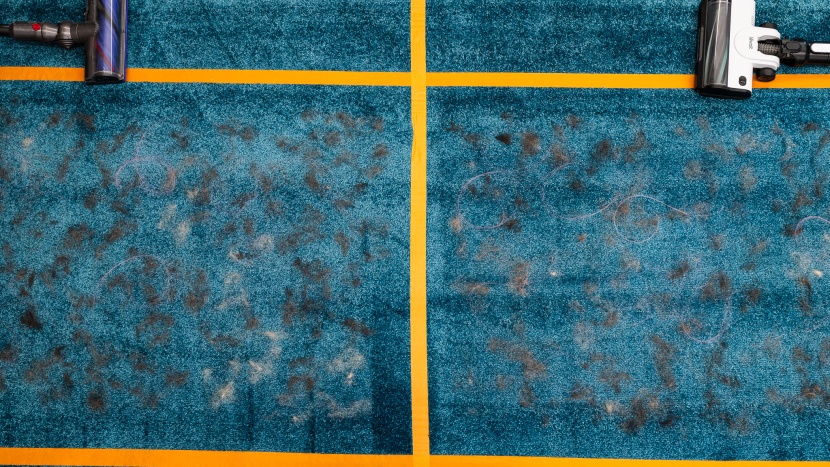
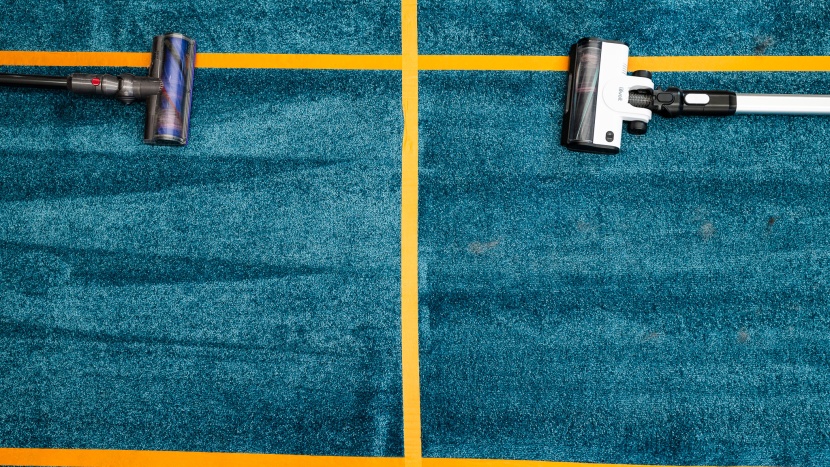
The LVAC-200 picked up 73% of the hair I put down for it. My qualm with its performance, however, was more qualitative than quantitative. Much of the hair was wrapped around the brush roller when I finished vacuuming rather than in the dustbin. This problem is by no means unique to this model; most cordless vacuums have some kind of anti-tangling brush roller technology, and few of them work particularly well.
In the case of this design, the brush roller is at least easy to remove and clean. But I'd still hesitate to recommend it for a household heavy on pet hair. Because it left clumps of hair throughout the test area, the carpet didn't feel clean, even with a respectable hair removal rate. Of course, in a real-world situation, I could have spent more time on the area, and I think that would have yielded better results.
Filtration
Filtration is perhaps the most involved of the metrics we test, but to us, it's also one of the most important. Air purity has real health implications, so we wanted to test each vacuum rigorously and thoroughly.
To see how much dust a vacuum kicks up while cleaning, we used flour as our test mess. It's not just something you're likely to spill in the kitchen—it also simulates a range of super fine particles, like pet dander and pollen. For each test, we sprinkled ⅓ cup of flour over the area, turned off the air purifiers, and let things settle for ten seconds. Then we ran the vacuum for up to 30 seconds (or until the flour was gone) and tracked the highest spike in small particle counts.
This was repeated three times with each vacuum. Because they can be absorbed directly into the bloodstream via the lungs, it's the smaller particles that often have the most health implications. But I'm no fan of dirt and dust in the house, either.
| Levoit LVAC-200 | |
|---|---|
| Small Particle Count | 34 |
| HEPA Filter | ✖ |
| Dylos Air Quality Designation | Excellent |
Long story short, this filtration system knocked it out of the park. There was no meaningful spike in particle count from the testing room's baseline on any of the three trials I ran it through. Filtration may be one of the less tangible metrics to base a vacuum decision on, but try a vacuum with poor filtration during pollen season and you'll see why it's important. The EPA has a great interactive tool to learn more about home air quality; one of the points it emphasizes is the importance of regular vacuuming. We found that the Levoit did a great job on filtration. But if you're sensitive to allergens or particularly concerned about air quality, you might want to check out our list of the best air purifiers for some extra filtration.
Ease of Use
Some cordless vacuums compromise on weight to gain power or battery life, while others require more involved maintenance. Some just don't move across the floor well. All of these factors can have a big impact on the experience of using a vacuum, and it's important to consider them when determining which model might be right for you.
One of my favorite things about this vacuum was how pleasant it was to use. From intuitive cleaning to easy swiveling, it just never felt like a pain. Those little conveniences add up to make vacuuming feel a whole lot less laborious.
Maneuverability
To test maneuverability, I created a little obstacle course to run all my vacuums through. This consisted of a bamboo mat to simulate uneven flooring, transitions from hardwood to carpet and back, some zigs and zags through cones to evaluate cornering, and then some furniture-specific challenges: under tables, around chair legs, and under a sofa.
The LVAC-200 was nothing short of a delight, rolling smoothly over lips and transitions, cornering effortlessly, and swiveling smoothly to hug the base of the furniture. It stretched under the couch easily, lying completely flat if needed. Best of all, when I finished the obstacle course, I could walk away from this vacuum without a second thought because, unlike the vast majority of stick vacuums, the LVAC stands up on its own. With a 3.3-pound motor head weight, it's also very light. It could easily be used overhead in its handheld mode and would be a great option for anyone who tires quickly or wants to save their arms for the gym.
Maintenance
Every vacuum needs maintenance. Sometimes, it can feel like half the task of vacuuming is cleaning filters, untangling hair, and dumping dustbins. This vacuum made all of that feel easy. There are two soft filters you should wash at least monthly, per Levoit. They're both super easy to access, remove, and replace. The dustbin and metal filter therein are similarly easy to access and rinse. And the brush roll head, which can accumulate long hair, pops out with the click of a button.
Helpful instructions come both with the vacuum and on Levoit's website. It was intuitive and quick, with no tools required. Because regular maintenance is a huge factor in a vacuum's longevity, I love to see a bargain model that can be cared for easily. A much more expensive vacuum could be useless in a couple of years if the maintenance is annoying enough that you just don't do it.
Uphostery & Attachments
The LVAC-200 comes with two attachments: one for crevices and one for pet hair. They are simple, and they work surprisingly well.
To test upholstery performance, I sprinkled a pillow and an ironing board with 1/16 cup of coffee grounds each. I used the 2-in-1 pet tool and found that it easily dispensed with around 93% of the grounds. I missed the super satisfying upholstery clean that comes with a motorized brush like the one found on the Dyson V12 Slim, but all in all, the LVAC-200 really impressed me with its user experience. In fact, it is tied with the Shark Vertex Pro Lightweight in my ease-of-use ranking of cordless vacuums and comes in at less than half the price.

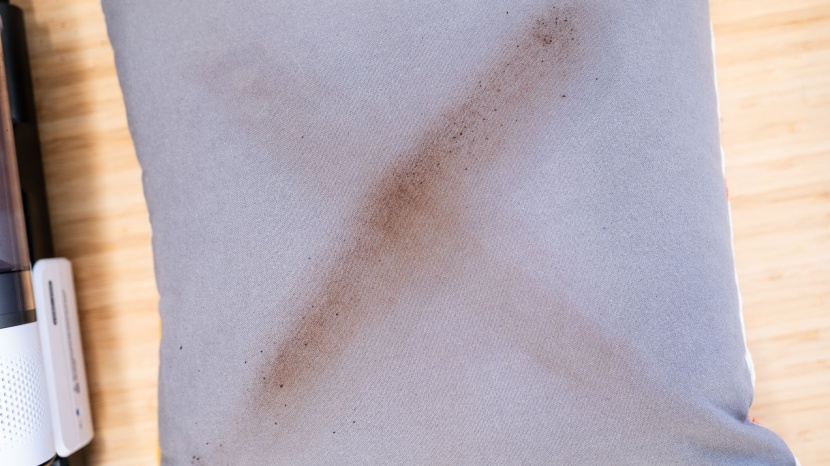
Battery
The battery is one of the limiting factors all cordless vacuums run up against. Batteries are both heavy and expensive, so there's a clear trade-off for longer life. I tested this product's run time and found that it could survive 35 minutes on the low setting and 17 on high. Seventeen minutes is actually quite a long life for a cordless vacuum on high, but that's because this vacuum's high setting is not particularly powerful. And because the LVAC doesn't have a 'detect' mode that toggles the vacuum from low to high depending on the substrate, it's on the user to remember to switch from high back to low, or see their vacuum die a lot sooner.
All in all, like most cordless vacuums, the LVAC-200 will probably require a couple of charge breaks to get through a whole house. If you live in a smaller space, or you're happy to split your vacuuming between a couple of sessions, this might not be a problem at all. I would happily use a charging break to finish other chores, take a walk, or eat a snack. But if you want to be sure you can get the vacuuming done in one fell swoop, it might be worth considering a corded model.
Should You Buy the Levoit LVAC-200?
A vacuum as affordable as the LVAC-200 can't be perfect for everybody. But if you're looking for a solid performance, easy use, and a palatable price, it might be perfect for you. While its lower-end suction would steer me away from recommending it to a pet owner or a shag carpet enthusiast, I think it can absolutely get the job done for the rest of us. If what you're after is a vacuum that will keep your house clean with no hassle and no payment plan, this is a great option for you.
What Other Stick Vacuums Should You Consider?
If you're willing to entertain higher prices, other cordless vacuums on the market may suit your specific needs better than a generalist like the LVAC-200. If you like a little more power, the Tineco Pure ONE S11 offers great suction without a substantial investment. And if you're looking to save even more, the Black+Decker Powerseries+ 20V costs just $150 and still offers decent performance.
Compare to Similar Products
 This Product Levoit LVAC-200 | |||||
|---|---|---|---|---|---|
| Awards | Best on a Budget | ||||
| Price | $200 List $149.96 at Amazon | $210 List $169.99 at Amazon | $150 List $114.17 at Amazon | $150 List $119.99 at Amazon | Check Price at Amazon |
Overall Score  |
|||||
| Star Rating | |||||
| Bottom Line | A vacuum that gets the job done without breaking the bank | This vacuum delivers an impressive clean for a budget-friendly model, holding its own against competitors that cost two or even three times as much | This stick vacuum is affordable, but it lacks performance compared to higher-priced options | For those who desire a lightweight vacuum that won't consume their hard-earned funds, this might be worth a look | Tempting for those already invested in the Ryobi-Sphere, but we would recommend spending on other budget vacuums |
| Rating Categories | Levoit LVAC-200 | Smoture VAC01 | Kenmore Elite CSV M... | Black+Decker Powers... | RYOBI 18V ONE+ Stic... |
| Carpet Performance (30%) | |||||
| Hardwood Performance (25%) | |||||
| Pet Hair (20%) | |||||
| Ease of Use (10%) | |||||
| Filtration (10%) | |||||
| Battery (5%) | |||||
| Specifications | Levoit LVAC-200 | Smoture VAC01 | Kenmore Elite CSV M... | Black+Decker Powers... | RYOBI 18V ONE+ Stic... |
| Max Mode Runtime | 17 min | 14 min | 14 min | 18 min | 21 min |
| Low Mode Runtime | 35 min | 43 min | 34 min | 26 min | 41 min |
| Storage | Standalone | Standalone | Wall mount | Wall mount | Standalone |
| Handheld Weight | 3.3 lbs | 3.5 lbs | 2.0 lbs | 3.5 lbs | 5.2 lbs |
| Suction | 274 Pa | 249 Pa | 149 Pa | 50 Pa | 473 Pa |
| Low Pile Cleaned | 86% | 87% | 77% | 73% | 58% |
| High Pile Cleaned | 42% | 42% | 20% | 24% | 20% |
| Hardwood Cleaned | 77% | 85% | 70% | 62% | 41% |
| Pet Hair Cleaned | 52% | 54% | 56% | 59% | 34% |
| Charge Time | 2.8 hrs | 4.1 hrs | 3.2 hrs | 4.7 hrs | 1.6 hrs |
| Dustbin Capacity | 0.8 L | 1.5 L | 1.0 L | 0.2 L | 0.6 L |
| Noise Level | 80 dBA | 80 dBA | 75 dBA | 78 dBA | 79 dBA |
| Trigger | No | No | No | No | No |
| Variable Suction Control | No | No | Yes | Yes, automatic | No |
| Model Number | LSV-V201-WUS | VAC01 | DS4095 | BHFEA18D1 | PCL720B |


